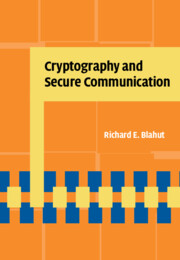Refine search
Actions for selected content:
48287 results in Computer Science
Computational Semantics with Functional Programming, by Jan van Eijckand Christina Unger .
-
- Journal:
- Journal of Functional Programming / Volume 24 / Issue 4 / July 2014
- Published online by Cambridge University Press:
- 09 April 2014, pp. 524-527
-
- Article
-
- You have access
- Export citation
TLP volume 14 issue 3 Cover and Front matter
-
- Journal:
- Theory and Practice of Logic Programming / Volume 14 / Issue 3 / May 2014
- Published online by Cambridge University Press:
- 09 April 2014, pp. f1-f2
-
- Article
-
- You have access
- Export citation
TLP volume 14 issue 3 Cover and Back matter
-
- Journal:
- Theory and Practice of Logic Programming / Volume 14 / Issue 3 / May 2014
- Published online by Cambridge University Press:
- 09 April 2014, pp. b1-b5
-
- Article
-
- You have access
- Export citation
Counting Independent Sets in Hypergraphs
-
- Journal:
- Combinatorics, Probability and Computing / Volume 23 / Issue 4 / July 2014
- Published online by Cambridge University Press:
- 08 April 2014, pp. 539-550
-
- Article
- Export citation
The First k-Regular Subgraph is Large
-
- Journal:
- Combinatorics, Probability and Computing / Volume 23 / Issue 3 / May 2014
- Published online by Cambridge University Press:
- 07 April 2014, pp. 412-433
-
- Article
- Export citation
CPC volume 23 issue 3 Cover and Back matter
-
- Journal:
- Combinatorics, Probability and Computing / Volume 23 / Issue 3 / May 2014
- Published online by Cambridge University Press:
- 07 April 2014, pp. b1-b2
-
- Article
-
- You have access
- Export citation
ROB volume 32 issue 2 Cover and Back matter
-
- Article
-
- You have access
- Export citation
CPC volume 23 issue 3 Cover and Front matter
-
- Journal:
- Combinatorics, Probability and Computing / Volume 23 / Issue 3 / May 2014
- Published online by Cambridge University Press:
- 07 April 2014, pp. f1-f2
-
- Article
-
- You have access
- Export citation
Introduction
-
- Article
-
- You have access
- Export citation
ROB volume 32 issue 2 Cover and Front matter
-
- Article
-
- You have access
- Export citation

Cryptography and Secure Communication
-
- Published online:
- 05 April 2014
- Print publication:
- 27 March 2014
Structure of complex networks: Quantifying edge-to-edge relations by failure-induced flow redistribution
-
- Journal:
- Network Science / Volume 2 / Issue 1 / April 2014
- Published online by Cambridge University Press:
- 03 April 2014, pp. 66-89
-
- Article
- Export citation









